
4th December 2025
Working in Dubai Education
Club member John Hopkins will talk on his post-UK retirement career in school improvement in Dubai and the UAE. He will touch on how he got involved the processes used and their impact. He will also give his personal impressions of living in Dubai and the Emirates.
_______________
15th January 2026
I Don’t Need a Microphone
Club member John Thurstan will talk about the trials and trauma involved in the installation of a sound system at Holy Trinity Church in Chesterfield. He will explore the reasons why, despite the highest quality of the system, some people still cannot hear what is going on. All this is in the context of his many years’ experience of working in ENT, and General Practice, but very little experience of Sound Engineering!
_______________
5th February 2026
Gaddafi’s Libya
Club member Tony Byrne will describe Gaddafi’s Libya as he experienced it when, with his family, he was living there between 1974 and 1980. Libya today is not the Libya that Tony knew, and he will talk about how the area has changed since the fall of the dictatorship.
(Most recent first. Click on the titles for fuller descriptions).
20th November 2025
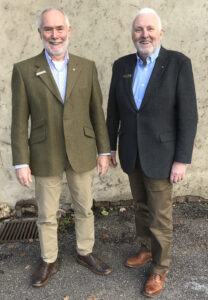
Tony Fry and Paul Davies
16th October 2025
To judge by the popularity of television and radio programmes devoted to the subject, crime thrillers are a source of continuing fascination to the public. Most of these are based on fiction but, in contrast, an actual murder committed in 1931 was the topic of this talk by club member, Steve Maybury.
The story, as related by Steve, was about an apparently contentedly married couple, Julia and William Wallace living in the Anfield area of Liverpool during the 1930s. William was an insurance agent whose habit was to spend his evenings playing chess at a club in a city centre café, leaving his wife at home. On the evening before the murder, a telephone call from a public phone box in Anfield was made to the café. The caller did not give his name but asked for a message to be given to William when he arrived there for his scheduled chess game. The message was for William to meet a potential client the following evening at an address some distance from Anfield. Therefore, on the day of the murder, William left home for his appointment and, travelling by tram, arrived at his destination only to have difficulty in finding the address which he had been given. Having sought directions from a number of people, he realised that the address did not exist, and he therefore returned home, where he discovered the body of his brutally murdered wife.
Despite all the available evidence from witnesses to William’s movements on that fateful evening and the seemingly impossibility of his committing the crime within the known time frame, the police were convinced that he had done the deed. He was brought to trial, found guilty of the murder and condemned to death. However, on appeal, the conviction was quashed on the grounds that the original verdict could not be supported having regard to the evidence. But, if William was not the murderer, who was? This was a question at the time and remains a mystery. There appeared to be no motive for it, no weapon was ever discovered, and no person was known to be sufficiently hostile to Julia to kill her.
In summing up, the speaker (who had been a Deputy District Judge in his working life) expressed his own view that the findings of the appeal were correct. And, of course, being intrigued by the whole story, many members of his audience enthusiastically added their opinions and conclusions.
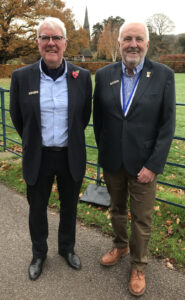
Steve Maybury and Paul Davies
16th October 2025
To many people in this country, the name of Marks & Spencer suggests the traditional British business but, in fact, it was founded by a penniless immigrant, Michael Marks who, in 1882, arrived in England unable to speak the language but who was determined to work hard to earn a living. The story of the famous retail business which bears his name and that of his partner, Thomas Spencer, was related today by club member Stefan Andrejczuk (whose own father had similarly escaped a repressive European regime albeit six decades after Marks).
Opening his talk with a summary of his own career, Stefan explained that, on leaving school he had worked for the bookseller W.H. Smith for four years until leaving to join M&S as a management trainee. He then spent the next 23 years with the company, rising through successive promotions to a senior position.
He continued by describing the development of M&S which started with Marks trading from a stall in Leeds market. By 1894, he realised that his expanding business needed someone to help in managing it, and he therefore entered a partnership with Spencer. In spite of Marks’ death in 1907, the business, by now a limited company, continued to prosper under the chairmanship of Marks’ son, Simon. Having visited the US in the 1930s, Simon introduced many of the retail strategies that he had witnessed there. These included scientific management and efficiency, customer-centric innovation, in-house research and product development, and pioneering staff welfare schemes.
Although these helped to create a business that was the envy of others, a number of major crises hit M&S in the 1990s and early-2000s. The company failed to keep up with changing consumer preferences and trends and faced serious competition. The management had become inefficient, and it was only under the new leadership of Stuart Rose from 2004 that matters began to improve. Many store closures followed during a period of restructuring, but some momentum had been regained until the latest crisis, a cyber attack in 2025 from which recovery has been a long and expensive process.
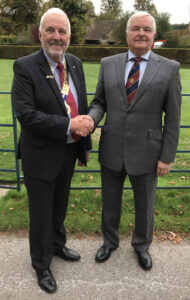
Paul Davies and Stefan Andrejczuk
2nd October 2025
‘Where would we be without our satnavs?’ The answer – in the case of those of us who had not taken the precaution of keeping a road atlas in the car – would probably be ‘Lost’. We have become increasingly reliant on the satellite navigation technology offered by the system but are generally ignorant of how it works. It was to explain the workings of satnav that a visiting speaker, Dr. David Allerton, Emeritus Professor of Computer Systems Engineering at Sheffield University was invited to speak at this meeting.
Professor Allerton started his talk by observing the contribution of satnav, a major development in engineering, to society. He outlined the functions of the major components of satnav systems and explained the orbits of the global positioning system (GPS) satellites to enable users on the ground (or in the air) to detect their position. Although a military system, the Department of Defense (sic) in the USA manages and maintains the constellation of satellites, making the system free to civilian users. He explained the limitations of GPS in terms of accuracy and susceptibility of jamming. Once position is measured from the satellite signals, the route to the destination position is determined from digitised maps, searching all the possible paths to extract an optimal route, often in a matter of seconds.
The talk concluded with Professor Allerton summarising the benefits and limitations of satnav systems and answering a wide range of questions from the audience.
When it is considered that a typical satnav includes a GPS receiver capable of detecting its position to an accuracy of between five and ten metres, a route finder that can compute an optimal route in a matter of seconds, and a moving map display, all for less than £150, the system is truly remarkable.
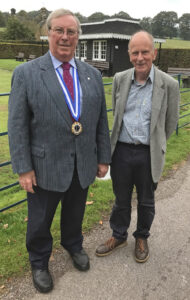
Christopher Jewitt and David Allerton
18th September 2025
Are we alone in the universe? After centuries of scientific development, we humans are no closer to a definitive answer, although we now have sufficient knowledge of the size and nature of the universe to arrive at the reasonable conclusion that we are unlikely to be the only sentient life forms to have evolved.
In addressing the question of whether or not there may be life elsewhere, the speaker at today’s meeting, club, member Paul Davies, discussed the evidence available to us. As he pointed out, claims for the existence of extra-terrestrials date back thousands of years but it has been only during the past couple of centuries, following major discoveries in astronomy, physics and mathematics, that making contact (either friendly or hostile) with such creatures has been thought feasible. However, there are major limiting factors to be considered in assessing the possibility of the existence of life in other parts of the cosmos, and the likelihood of being able to make contact. Firstly, there is the sheer scale of the universe. Not only is it spatially vast, but it is populated by billions of galaxies, each of which contains billions of stars. It is reasonable to assume that if only a tiny proportion of these stars are orbited by planets similar to those of our own solar system there must nevertheless be a significant total number of these exoplanets with the potential for life to evolve.
Next, there is the question of the level of evolution achieved by life on these planets and how this compares with that on Earth. We can be certain that other ‘intelligent’ life does not exist within our own solar system but, in the past few years, evidence has come to light from advanced exploratory spacecraft that conditions favourable for the evolution of primitive life forms exist on the moons of the outer planets. There also seems to be evidence that primitive life has existed on the planet, Mars.
Beyond our solar system, any contact between alien beings and ourselves would need to take into account the time taken for any electromagnetic messages (travelling at the speed of light) to reach us. It could be that by the time the signal is received, one or both of the life forms could no longer exist.
In his concluding remarks, the speaker expressed his own belief that there is almost certainly life elsewhere in the universe and it is highly possible that there are intelligent life forms out there; but it is unlikely that we shall succeed in making contact.
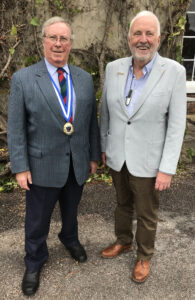
Christopher Jewitt and Paul Davies
4th September 2025
The overwhelming majority of the general public would probably experience some difficulty if asked to define the meaning of Social Sciences. This is a field of study that is often misunderstood or even a source of mystification and so, at this meeting, it fell to Club member David Webb (Emeritus Professor of Social Sciences at Nottingham Trent University) to explain this particular branch of science.
David opened his talk by describing the differences between sociology and social science. In both cases they encompass the understanding and study of the behaviour of human beings and the relationships between them. However, social science includes other related topics such as economics, psychology and anthropology.
To illustrate the diverse ways in which people react to situations that are different from their own experience and attitudes, the speaker gave a number of examples about which a more nuanced view could be taken than that commonly held. For instance, in the folk memory of the Second World War, Bomber Command has played second fiddle to the heroic endeavours of Fighter Command. This might be to do with the ideal of individual, almost chivalric, combat of the young, sometimes socially privileged fighter pilot, whereas bombers have a more industrial approach to warfare, where killing (often of civilians) is remote and less invested with glamour – and, of course, there was the residual collective guilt that ‘carpet-bombing’ was tantamount to a war crime.
Another topic was that of the traveller community. David described how the social reaction to those who are not settled, the labelling of them as ‘deviant’, the sanctioning of their life style and the shaping of travellers’ own identity as ‘outsiders’ all lead to a spiral of antagonism between the settled and the traveller – from which it becomes progressively difficult to pull back.
Finally, he considered ‘charity’, as being something of which we are all in favour. “Or are we?”, he asked. At first sight, the voluntary gift of money or time to those in need seems honourable, but there is plenty of evidence that charitable giving serves as way for the giver (especially if wealthy) to enhance their social standing, to build up their reserves of influence and to shape the direction of the lives to whom their giving is directed. Those in receipt of charity may be required to display their need, which easily places them in the position of supplicant, and may also reinforce stereotypes that certain groups are self-evidently deserving. It’s not an easy transaction (based on power), raising questions over who may in fact be benefitting from the giving of charity.
This was an interesting talk which provided much-needed clarity to the subject of Social Science.
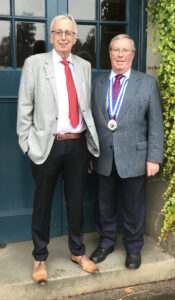
Davide Web and Christopher Jewitt
21st August 2025
With this year’s eightieth anniversary of V.J. Day commemorated in mid-August, it was appropriate and, as it happened a coincidence of timing, that this talk was on the subject of Japan. The speaker, club member Ian Johnston, had visited the country in February 2024 and, in his talk, he described his impressions of its people and their culture, together with an overview of Japan’s history, geography, geology and economy.
As Ian pointed out, the four main islands of Japan are notable for their mountainous terrain which means that the population of 126 million is concentrated in the coastal lowlands. Here, as throughout history, the human settlements have been vulnerable to the potentially devasting effects of earthquakes and their associated tsunamis attributable to Japan’s position on the geologically unstable ‘Ring of Fire’ zone of volcanic activity. He also outlined the history of the country during which, for many centuries, it was isolated – until the mid-nineteenth century. Following an attempted coup in 1932, it developed a militaristic approach to its neighbours resulting in an invasion of China in 1937. The 1942 attack on Pearl Harbour brought the USA into World War II, which was ended by the surrender of Japan on 15th August 1945.
Addressing his own question, “What’s the Difference?”, the speaker discussed the ways in which the social structure differs from that of other countries and how the post-war economy has developed. Initially, in the years of American occupation (1945-52) reconstruction of Japan’s infrastructure and manufacturing industries led to an economic boom. However, in the 1990s the economy was hit by a stock market crash followed by period of low growth. In spite of these difficulties, Japan is able to sustain a high level of debt at relatively low interest rates because it is fiscally cautious.
Ian concluded his talk by showing several photos which he had taken during his visit. These illustrated not only the scenic nature of much of the country but also some of the highly developed technology, such as the famous ‘Bullet’ high-speed trains, to be found there.
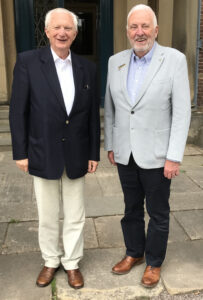
Ian Johnston and Paul Davies
7th August 2025
Few people who have been fortunate enough to see elephants in their natural habitat in Africa can fail to be impressed by these remarkable animals. At today’s meeting, his enthusiasm and fascination for this subject was explained by the speaker, Club member, Richard Chaplin. Illustrating his presentation with photographs taken during his many trips to East and southern Africa, Richard described the evolution, physiology and behaviour of the two species of elephant, African (Loxodonta Africana) and Asian (Elephus maximus), but with particular emphasis on the former (whose Latin name refers to the lozenge-shaped indentations in its molar teeth.)
Evolving about six million years ago from a source common to the two species of elephant and mammoths, the African group further evolved into two subspecies, Savanna and Forest which, as their names indicate, are generally found in different environments. Each type has distinct features, but interbreeding occurs where their ranges overlap. Standing four metres tall at the shoulder and weighing up to seven tonnes, the males are notably bigger than the females. Both sexes can live up to 60 or 70 years and, in addition to their well-known ‘trumpeting’, can communicate by means of a very low frequency rumble that can carry for a distance of 20 km. Apart from the massive tusks, an elephant’s trunk is probably the most unusual feature of the animal in that it is, in many ways, more versatile than the human hand.
The speaker continued by describing the animals’ diet which is a varied mix of vegetable matter ranging from grass and leaves to roots, sticks and even whole branches. As for their relationship with each other, their society is matriarchal and particularly protective of their young. They are generally tolerant of the presence of humans though will invariably assert their dominance; they seldom tolerate predators and will seek to displace them; in any event if they feel threatened they can charge, usually in a mock display, but a full charge is terrifying and can have severe outcomes.
This was a most informative talk much appreciated by Richard’s audience, many of whom had been unable to attend the Zoom meeting in 2020 when he first gave it.
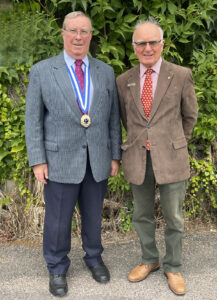
Christopher Jewitt and Richard Chaplin
17th July 2025
This was the third in a series of talks by club member John Hayes. The first two, given by him in 2022 described his life experiences from starting out as a ‘born again’ Christian, through a series of personal upheavals to reach a point at which he found that he had lost his faith. After a succession of unskilled or semi-skilled jobs, he rediscovered his sense of purpose when he found employment in the ‘legal costs’ business, eventually establishing his own company which grew until he employed over a hundred people in a dozen offices around the UK.
In this latest talk, he described the principal things that have given, and continue to give, meaning to his life in retirement – the enjoyment of walking in the countryside, listening to classical music, the study of fine art, his work, and politics. He is an active supporter of the Welsh National Opera and, although no longer a member, was once very much involved with the Labour party.
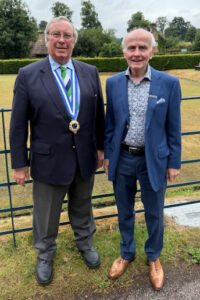
Christopher Jewitt and John Hayes
3rd July 2025
Air transport these days is so overwhelmingly dominated by jet-powered aircraft that it can be easy to overlook the amount of effort and determination that was involved in developing the jet engine. Perhaps the most famous pioneer in jet engine technology was Frank Whittle, the story of whose life and career was related to us today by club member Brian Holland. Although now retired, Brian had been an aeronautical design engineer in his career, and therefore he was well qualified to talk on this subject, much of which involved an understanding of the detailed technology underlying the evolution, over several decades, of the jet engine.
Frank Whittle was born in Coventry in 1907, but his family soon moved to Leamington Spa. Having won a scholarship to the local grammar school, Leamington College, he displayed practical engineering skills and spent much of his spare time in the local reference library studying, amongst other things, the theory of flight. Between 1923 and 1926 he served an aircraft apprenticeship which culminated in a recommendation by his commanding officer for officer training at RAF Cranwell College. It was during his time at Cranwell that he learned to fly and, as a requirement of his academic course, he produced a thesis on potential aircraft design developments. Recognising the limitations of propeller engines at higher altitudes he examined ways of developing an alternative means of thrust which resulted in his patent for a turbojet which was granted in 1930. The proposal consisted of a compressor delivering air to combustion chambers which in turn delivered heated and expanded air to a turbine to drive the compressor, the residual energy being accelerated through propelling nozzles to generate thrust.
The speaker continued by describing Whittle’s RAF career, during which time he continued working on his concept designs but was unable to get support from the Air Ministry. Then, in 1936, with others, he set up Power Jets Ltd with the aim of further developing his ideas. Eventually, during the height of World War II, the first British turbojet-engined aircraft, the Gloster E28/39 was produced. This was followed in 1943 by the Gloster Meteor – the only British jet aircraft to engage in combat operations during the war. Thus, the stage was set for the rapid development of military and civil jet aircraft after the end of hostilities.
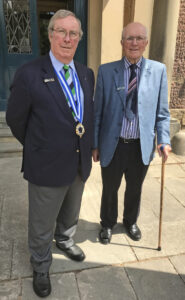
Christopher Jewitt and Brian Holland
19th June 2025
The membership of this club includes people with widely varied personal career histories, but member Rod Prince gave this talk on a most unusual topic by describing his experiences over a 35-year association with camel racing in The United Arab Emirates. Having joined a specialist UK manufacturer of animal feeds in 1988, Rod soon became involved in developing improved feeds for the racing camels and other animals – such as horses and deer – kept and prized by the rulers of the Gulf States; an association that continued until his retirement in 2023.
As the speaker pointed out, probably because of its unconventional appearance and ungainly way of moving, the camel has been described as a horse designed by a committee. However, to balance this somewhat unkind assessment, the camel must be given credit for the ways in which it is adapted to the harsh conditions in which it lives. Their humps let them store 20kgs of fat, which they can live off for weeks and even months. They can lose 25% of their bodyweight over a continuous period of starvation, and they can survive 7-10 days without water – and make up the loss in just ten minutes by drinking up to 40 gallons in one go. And obviously, being desert dwellers, they can tolerate huge variations in temperature.
Rod continued with a description of the features of the camels which are bred specifically for racing, in contrast with those used as beasts of burden. In fact, racing camels share many characteristics with racehorses, being required to achieve high speeds (of up to 40 mph), if only for relatively short distances. Apart from speed, a racing camel needs to have stamina, agility and, of course, heat tolerance. The history of camel racing is deeply rooted in Bedouin society with these animals being an indication of the wealth, power and prestige of their owners. Races are now a multi-million-dollar industry with huge-value prizes awarded to the winners. For this reason, an individual animal can cost up to $3 million. Even higher sums can be demanded in the case of camel beauty competitions in which, among other physical attributes, they are judged on the length of their eyelashes. Yes: really!
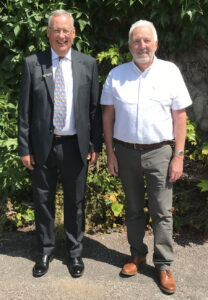
Rod Prince and Paul Davies
5th June 2025
Ask most people to name the largest of their body’s organs and they would probably choose an internal one, such as the liver, brain, lungs, heart, or kidneys; but far larger (and heavier) than any of these is the skin. This was the subject of today’s talk by club member, David Gawkrodger, who is Honorary professor of dermatology at Sheffield University.
Opening his presentation with a description of the structure of the skin, David also explained its main functions which include serving as a barrier against injuries and ultra-violet light penetration, and as an immune defence against external agents and infections. At the same time, it acts to prevent the loss of body fluids, and it regulates the body’s temperature. Of particular relevance to his older-generation audience, he discussed the process of skin-aging, most of which is due to the effects of sunlight. For this reason, and to reduce the threat of developing skin cancer, there are preventative measures which should be adopted throughout life, the most important of which is protection against the sun’s harmful radiation. Other effects of aging manifest themselves in hair-loss (for both men and women) and degradation of the nails on fingers and toes.
The speaker also described, with illustrations of typical examples, some types of skin conditions such as eczema, psoriasis, acne and cancer. Many of these, especially eczema are very common in the population. Different treatments have been developed over many years but now most involve the use of drug therapy, although skin cancers usually need to be removed surgically or by radiotherapy. The current fashion for tattoos poses few risks these days, but artificial nails cause damage to the natural nails to which they are attached.
David’s talk gave a most instructive and fascinating insight into this aspect of the body that is very often taken for granted.
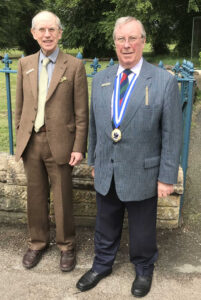
David Gawkrodger and Christopher Jewitt